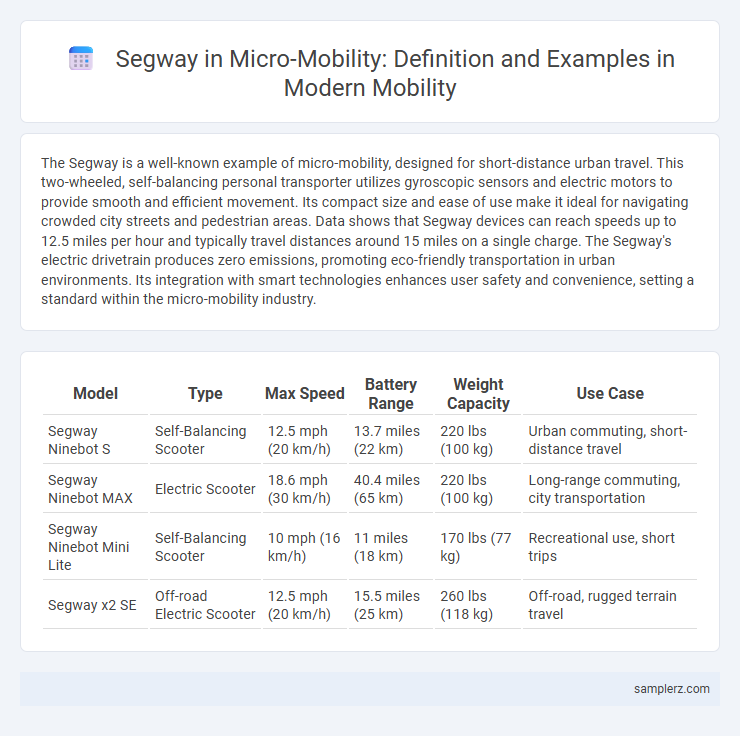The Segway is a well-known example of micro-mobility, designed for short-distance urban travel. This two-wheeled, self-balancing personal transporter utilizes gyroscopic sensors and electric motors to provide smooth and efficient movement. Its compact size and ease of use make it ideal for navigating crowded city streets and pedestrian areas. Data shows that Segway devices can reach speeds up to 12.5 miles per hour and typically travel distances around 15 miles on a single charge. The Segway's electric drivetrain produces zero emissions, promoting eco-friendly transportation in urban environments. Its integration with smart technologies enhances user safety and convenience, setting a standard within the micro-mobility industry.
Table of Comparison
| Model | Type | Max Speed | Battery Range | Weight Capacity | Use Case |
|---|---|---|---|---|---|
| Segway Ninebot S | Self-Balancing Scooter | 12.5 mph (20 km/h) | 13.7 miles (22 km) | 220 lbs (100 kg) | Urban commuting, short-distance travel |
| Segway Ninebot MAX | Electric Scooter | 18.6 mph (30 km/h) | 40.4 miles (65 km) | 220 lbs (100 kg) | Long-range commuting, city transportation |
| Segway Ninebot Mini Lite | Self-Balancing Scooter | 10 mph (16 km/h) | 11 miles (18 km) | 170 lbs (77 kg) | Recreational use, short trips |
| Segway x2 SE | Off-road Electric Scooter | 12.5 mph (20 km/h) | 15.5 miles (25 km) | 260 lbs (118 kg) | Off-road, rugged terrain travel |
Introduction to Segway in Micro-Mobility
Segway is a pioneering brand in micro-mobility, offering electric personal transporters designed for short-distance urban travel. These self-balancing scooters use advanced gyroscopic technology to provide smooth and efficient movement, making them ideal for last-mile commutes and crowded city environments. With their compact design and eco-friendly operation, Segways contribute to reducing traffic congestion and carbon emissions in urban mobility systems.
Historical Evolution of Segway in Urban Transport
The Segway revolutionized micro-mobility with its launch in 2001, introducing self-balancing electric transport that transformed short-distance urban travel. Early adoption in major cities highlighted its potential for reducing traffic congestion and carbon emissions. Over time, advancements in battery life, motor efficiency, and smart technology enabled wider integration into shared mobility programs and last-mile transportation solutions.
Key Features of Segway Devices for Micro-Mobility
Segway devices for micro-mobility feature self-balancing technology, allowing intuitive control and stability on various terrains. Their electric motors provide efficient, zero-emission transport with speeds typically ranging from 10 to 15 mph. Compact design, lightweight materials, and smart connectivity options enhance portability and user experience for urban commuters.
Segway’s Role in First and Last Mile Connectivity
Segway plays a crucial role in first and last mile connectivity by providing efficient, compact, and eco-friendly micro-mobility solutions ideal for bridging short distances from transit hubs to final destinations. Its electric scooters and personal transporters enable users to navigate urban environments quickly, reducing reliance on cars and alleviating traffic congestion. Data from urban mobility studies show that Segway devices increase accessibility to public transportation, enhancing overall travel convenience and reducing carbon emissions.
Environmental Benefits of Segway in City Mobility
Segways contribute to reducing urban air pollution by offering an electric alternative to gasoline-powered vehicles, which emit zero direct emissions. Their compact size and efficient energy use help decrease carbon footprints and alleviate traffic congestion in densely populated cities. Widespread adoption of Segways in city mobility supports sustainable transportation goals and promotes cleaner, greener urban environments.
Safety Considerations for Segway Riders
Segway riders must prioritize wearing helmets and protective gear to reduce injury risks during sudden stops or collisions, as these vehicles can reach speeds up to 12.5 mph. Regular maintenance checks on brakes and tires are essential to ensure the Segway's stability and responsiveness on various terrains. Riders should also follow local traffic regulations and use designated bike lanes to enhance safety and prevent accidents in urban micro-mobility environments.
Regulatory Framework for Segway Use in Urban Areas
Segway usage in urban micro-mobility is governed by diverse regulatory frameworks that emphasize safety standards, speed limits, and designated riding zones. Cities like Amsterdam and San Francisco enforce helmet mandates and restrict Segway access on sidewalks to reduce accidents and pedestrian conflicts. Compliance with local regulations ensures Segway integration supports sustainable urban transportation and enhances mobility options without compromising public safety.
Challenges Facing Segway Integration in Micro-Mobility
Segway faces challenges in micro-mobility integration due to regulatory restrictions in urban areas that limit vehicle types and speeds, hindering widespread adoption. Safety concerns, including rider accidents and pedestrian interactions, create obstacles for city planners and insurance frameworks. Limited battery life and infrastructure gaps further restrict practical use, complicating seamless integration into existing transportation networks.
Successful Segway-Sharing Programs Worldwide
Segway-sharing programs in micro-mobility have seen significant success in cities like Paris, San Francisco, and Beijing, where convenient access and eco-friendly transport boost urban mobility. These programs leverage GPS tracking, mobile app integration, and user-friendly payment systems to enhance rider experience and operational efficiency. Data from these cities show increased last-mile connectivity and reduced traffic congestion, underscoring Segway-sharing as a sustainable solution in modern urban transport networks.
Future Prospects of Segway in Smart Urban Mobility
Segway is poised to revolutionize smart urban mobility by integrating advanced AI navigation and IoT connectivity, enabling seamless and efficient micro-mobility solutions. Enhanced battery technologies and lightweight materials will extend range and durability, making Segways a practical choice for first- and last-mile urban commutes. Collaboration with city infrastructure for dedicated lanes and charging stations will accelerate adoption, reducing traffic congestion and carbon emissions in future smart cities.

example of segway in micro-mobility Infographic
 samplerz.com
samplerz.com